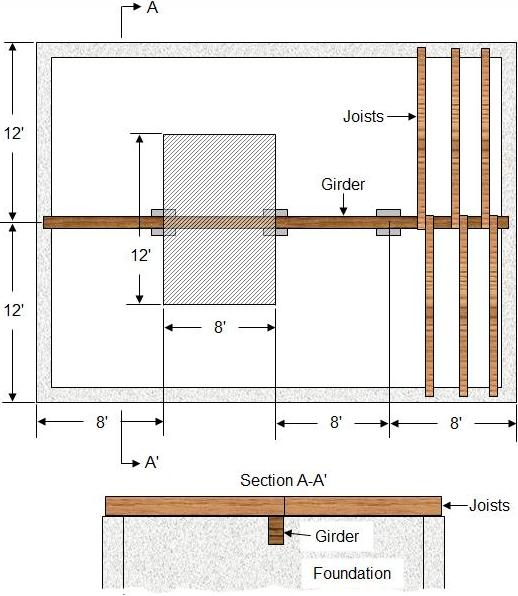First we must determine which portion of the floor will be supported at the perimeter of the house and which must be supported by the girder. We have illustrated our potential floor framing plan in Figure 4. Included is a section through that plan at the point at the point indicated by the lines with the arrows at the ends. (The letter A-A' identifies the section and shows exactly where on the plant the cut is taken). We will analyze the requirements for four spans of 8 feet each.

Figure 4 - Floor framing plan
Since the joists are spanning the north-south direction, it is obvious that he east and west perimeters of the building must only support the weight of the walls above them (except for the spot on which the ends of the girder rests). The center girder supports half the weight of the floor joists as indicated on the framing plan Figure 3 by the shaded portion. If the total floor is 24 feet wide and the girder is placed midway between north and south perimeters of the building, the girder will be supporting half of each of the 12 foot spans, that is, a total of 12 feet of width. If we isolate, for calculation purposes, the part of the floor system directly supported by the girders, we can add up the loads that will be placed on it.
Live loads are the first consideration. Since we are designing the first floor of the house we are required to design for a minimum of 40 psf.
Note: Always check local building codes to ensure that load design criteria meets or exceeds building codes in your area.
The dead loads, the weight of the materials in the joists, subfloor, finished floor, etc., are about 10 psf. The total live load (L.L.) and dead load (D.L.) are 50 psf, 50 psf × 12' × 8' = 4,800 lbs.
If there are load-bearing partitions that either rest on the girder or on the section of floor that the girder supports, these loads must be considered too as they will be taken on by the girder (See section on dead loads).
The next calculation requires us to guess the weight of the girder itself. Since we don’t know what the girder will be, we have no idea of its weight. We guess that the girder will be a 4 × 10 (This is an educated guess on our part. The joists are 2 × 8’s, we assume that the girder will have a larger cross-sectional area.)
Dead Loads (D.L.)
When calculating loads, both live loads and dead loads must be accounted for. Table 1 gives the weights of various building materials and composite structural items. Most of the listings are per square foot, which means that if you are trying to determine the weight of a 2 × 4 stud wall with 1/2″ drywall on both sides of the studs, you would multiply the weight of the wall per square foot (8.2 lbs.) X the dimensions of the wall (as an example, 8' high by 12' long) = 787.2 lbs.
